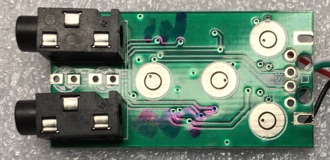A Quick Look At Two USB Sound Cards

2 USB Sound Cards
Thursday, February 10, 2022

USB Sound Cards are basic computer interfaces for a mic and headphones. I guess they’re called “Sound Cards” because they function like the old SoundBlaster cards? They range in price from a dollar up. I took a look at a couple of basic models, one no name which came bundled with a cheap microphone, and one from Amazon for $12.98.
https://www.amazon.com/Adapter-CableCreation-External-Windows-Drivers/dp/B01H2XF8V8/
They appear to be based on a single chip like the Cmedia CM108B, containing a USB interface, ADC and stereo DAC, control inputs and outputs, and interface to external I2S logic. Data sheet can be found here: https://www.cmedia.com.tw/support/download_center
Opening the no name dongle reveals that it has been made as cheap as possible. The bare chip is stuck on the circuit board under a blob of epoxy. Every part of the data sheet circuit that can be eliminated has been. No power filter capacitors. No output coupling capacitors. That explains why it sounds so awful just playing music. It puts out 1.5V DC to the earphones, which will push the drivers off center and could damage delicate types like In-Ear-Monitors. If your power amplifier is DC coupled, kiss your speaker goodbye. The lack of power filtering means noise from the computer’s 5V power buss goes directly into the mic and the analog parts of the chip. Technically, it does work, but performance is unacceptable for anything but a toy.


On the top of the circuit board we see places for two LEDs, one to show mic enabled, and one to show active data transfer. There are 4 pads for pushbuttons to raise and lower volume, mute the mic, and mute sound output. On the bottom we see pads for output capacitors which have been bypassed with 33 ohm resistors. There are pads for another capacitor, but power filter and other recommended circuit components are completely missing.
Both dongles supply “3V Plug In Power” which means about 2.8V from a pin on the chip through a 2.2K resistor. It is applied to both tip and ring of the mic jack, which are tied together in both gadgets. I was wrong thinking that these mic adapters supply 5V. It’s closer to half that.
There is no obvious way to open the Cable Creation case, which is made of aluminum with plastic ends. It’s nice enough and works well enough that I won’t destroy it today. It does have output capacitors and some power filtering, as evidenced by no DC on the headphone jack and much less noise on the mic input.
All of these low end converters are 16 bits, 44.1 or 48KHz sample rate. “CD quality” in other words. Adequate for most purposes, but no dynamic range to spare, and default gain as supported by native USB drivers in Windows and MacOS is on the low side. The chip apparently can supply another 20dB of gain, but I haven’t found how to enable it. Intended as a basic USB interface for an electret mic capsule containing an FET in common source configuration, and close talking, it does the job.
It is clear that not all of these are the same. Some have been cheapened so much they barely work.
Caveat emptor. These will go into the box of USB hubs, old USB mice, and odds and ends. I can’t think of uses for such a device in professional recording or high fidelity playback systems.

